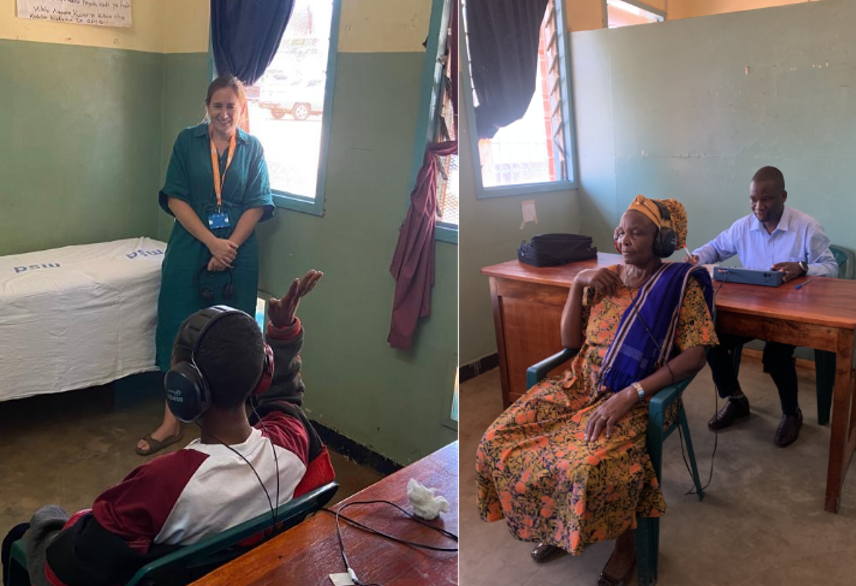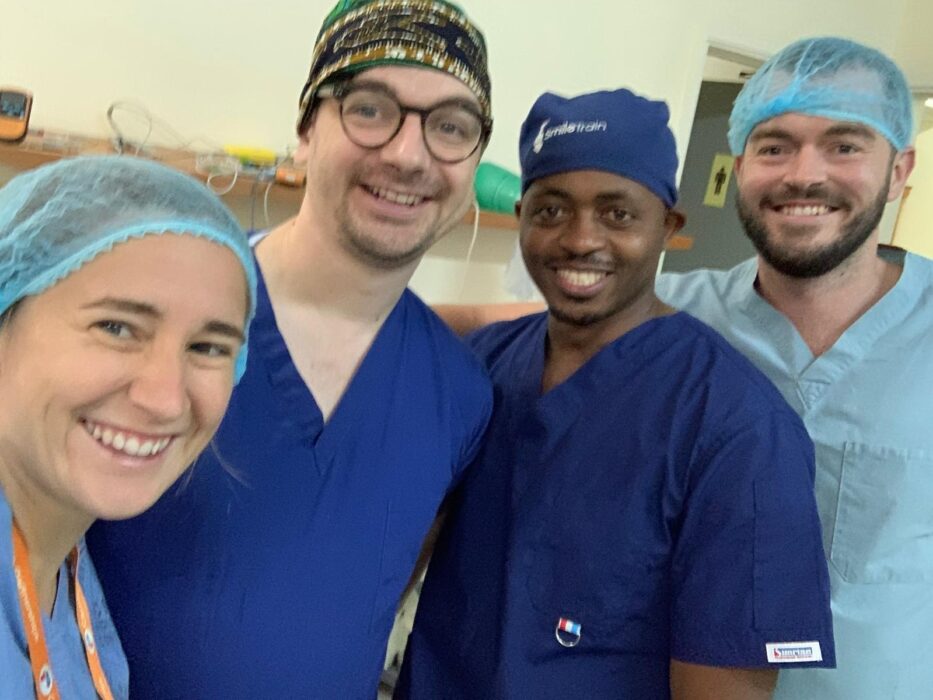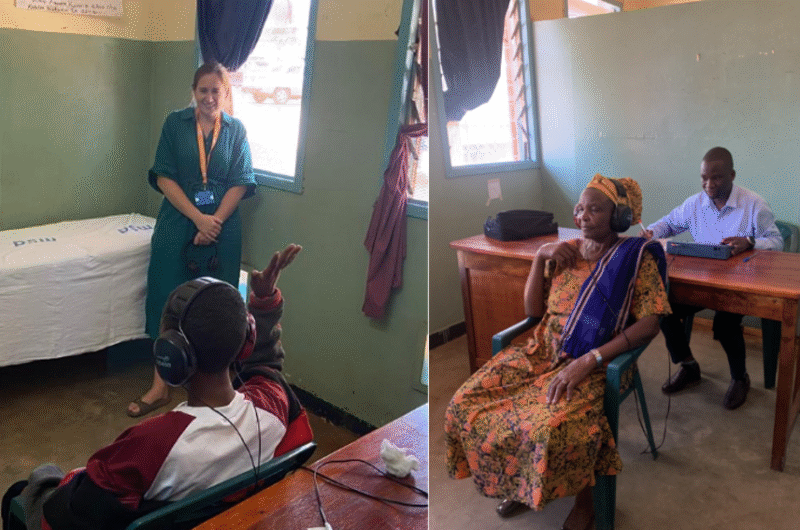By Rachael Collins
Rachael is an ENT Surgical Registrar and 2025 East of England Global Health Fellow. Rachael is the UK lead for a project that aims to improve access to ENT care in rural regions in partnership with Kilimanjaro Christian Medical Centre (KCMC) in Tanzania. In this blog, she reflects on the impact of the visit and the value of the experience to her NHS practice.
As part of my Global Health Fellowship, I am thrilled to help lead a partnership focused on addressing critical gaps in ENT care in Tanzania. In partnership with Dr Kenny Mlay – an ENT Consultant at KCMC, Tanzania – we have designed a project with two complementary pillars that aim to transform access to ENT care and quality of training.
The focus of this visit was pillar 1: Improving access to surgical care in rural regions by enhancing diagnostic capability within ENT outreach clinics. A core objective of the pillar is to expand ENT outreach clinics in rural Tanzania, where access to specialist care is limited and many patients are unable to travel to tertiary centres. The introduction of portable equipment, particularly nasendoscopy scopes is central to this as it supports timely assessment and diagnosis of laryngeal and throat pathology directly within the community. This can reduce unnecessary referrals, alleviate patient anxiety, and enable more efficient triaging and treatment.
Planning ahead to maximise visit impact
This project was designed to address local needs identified through qualitative research and ongoing collaboration with clinicians in Tanzania. It has been developed to be sustainable, equitable, and locally led to support both immediate clinical improvements and long-term capacity building.
Ahead of the visit, the team completed a needs-based assessment template to enable documentation of presenting complaints, diagnoses, investigation plans and follow-up strategies for patients attending outreach clinics. A key focus was identifying patients requiring transfer to KCMC. We also evaluated hearing screening tools and completed an analysis of the local ENT disease burden. Ultimately this will help to inform which equipment will deliver the greatest benefit to patients in these settings.
Leading up to the visit, I worked closely with Dr Mlay to develop tailored data collection tools for both ear and head and neck patients. My previous work in outreach settings, notably ear camps in Malawi (Malawi Hearing Project – Cambridge Global Health Partnerships), significantly informed my approach to this project. From Malawi, I learned the importance of being focused and deliberate in what data to capture – too much data could overwhelm the team and limit the number of patients we’re able to see, while too little could compromise the quality and utility of our research outputs.
Before travelling to Tanzania, we also prepared the research ethics application and data collection tools. Dr Mlay organised an audiologist to join and coordinate the clinics with the community hospital where we would be based. We also built flexibility into the visit schedule by including a day at KCMC at the end of the visit. This allowed us to ensure all physical records remained with Dr Mlay while efficiently compiling a clean, usable electronic dataset for our research.

Expect the unexpected: Flexibility as a core mindset for effective global health delivery
Sometimes things don’t go to plan! Due to delays in receiving grant funding, we arrived in Tanzania without any of our new equipment. Contrary to our initial disappointment, in some ways, this was a key clinical learning moment for the team as it allowed us to conduct a genuine needs assessment and experience first-hand the limitations faced by these clinics. Still, it was deeply challenging to see so many patients with hearing loss who could have benefited from something as simple as a hearing aid, yet we had very little to offer. This was especially difficult with children, where hearing loss has profound implications for speech, language development, and education.
In some ways, this was a key clinical learning moment as it allowed us to conduct a genuine needs assessment and experience firsthand the limitations faced by these clinics.

Delivering impact despite challenges
I am pleased to share that we saw 123 patients over three clinic days. I find clinical work in the NHS incredibly rewarding, but in this setting, even small interventions can have a remarkable impact. Dr Mlay usually runs this clinic by himself which can be overwhelming. Having three extra ENT surgeons meant more time could be spent with each patient.
One case that stayed with me was a one-year-old child with peri-orbital cellulitis. She was unable to open her eyes; a red flag in the UK that would typically prompt an urgent CT scan due to the risk of intracranial/intraorbital spread. What made it more concerning was that she had already been on antibiotics for 48 hours. I reviewed her treatment and added some additional medications, including adrenaline nasal drops, and strongly urged her mother – who was understandably distressed – to take her to the main hospital that day. The following morning, we learned that the mother and child were still at the community hospital. We reviewed the child again and were amazed to see a marked clinical improvement. Though still unwell, she was now able to open her eyes. It was a moment of relief, but also a sobering reminder of the adversity that families face in these settings. Through a translator, the mother explained that she simply couldn’t afford the bus fare to KCMC.
It’s one thing to read about deprivation, but coming face to face with it brings a different level of understanding. It reinforces how transformative even modest improvements in basic equipment and access can be. This experience underscored the urgency and potential impact of our work, and the importance of ensuring that future visits are better resourced to meet the needs that we now understand more clearly.
It was a moment of relief, but also a sobering reminder of the adversity that families face in these settings.


Piloting new digital tools
During the visit, the team were also able to trial the WHO’s HearWHO app, comparing its performance to standard pure tone audiometry to assess its utility in low-resource settings. In parallel, we began evaluating the HaNC-RC head and neck cancer screening tool to determine its validity in the outreach context. These research activities will contribute to a broader understanding of ENT disease burden and diagnostic gaps in rural Tanzania. Back home we will work with Dr Mlay to publish papers with the data collected and use the needs assessment to inform purchasing of equipment.

Beyond clinical impact: Building relationships
Beyond the clinical and research goals, the visit fostered deeper collaboration with local healthcare providers and reinforced the importance of locally led service delivery. The experience highlighted the challenges and opportunities in global health outreach, underscoring the need for sustainable, needs-driven solutions that empower communities and strengthen regional capacity.
Applying global health insights to NHS practice
The outreach clinics offer many insights that could inform and improve practice within the NHS. One of the most striking lessons was the value of focused, needs-based data collection. Through careful planning and collaboration with local clinicians, we developed tools that balanced clinical efficiency with meaningful research output. I think it would be beneficial if this kind of approach could be adapted for UK outreach and community clinics, helping to streamline audits, support funding applications, and ensure that services are tailored to actual patient needs.
The experience also challenged assumptions about innovation. Despite limited resources, the Tanzanian clinics demonstrated how portable diagnostic tools such as nasendoscopy scopes and mobile hearing apps can transform care delivery. There is a new drive in the NHS to deliver care more locally. Such tools could be introduced into UK community ENT services to reduce unnecessary referrals and enable earlier diagnosis.
Perhaps most surprising was the discovery that a remote Tanzanian hospital had a fully integrated electronic patient record system linked to its tertiary centre. In contrast, many NHS trusts still operate fragmented systems that do not communicate with one another. This highlights the need for a unified, interoperable digital infrastructure in the UK and suggests that we can learn from global partners who have leapfrogged legacy systems.
This highlights…..that we can learn from global partners who have leapfrogged legacy systems.

Finally, I think the visit reinforced the importance of equity in service design. Witnessing patients unable to access care due to transport costs was a sobering reminder of the barriers that persist in all health systems. It underscored the need for NHS services to account for social determinants of health and to design care pathways that meet patients where they are—geographically, financially, and culturally. These reflections offer a compelling case for rethinking how we approach outreach, innovation, and equity in the NHS.

Return to blogs

